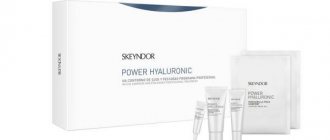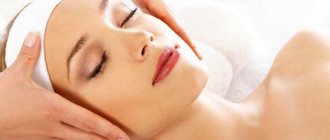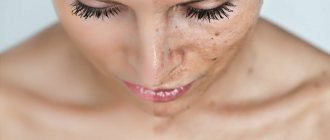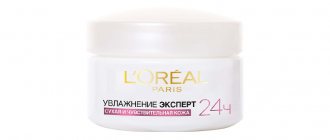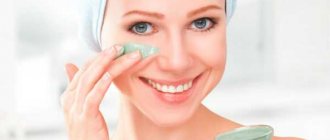What is this?
Natrii hyaluronas, Sodium hyaluronate (sodium hyaluronate) is a polysaccharide consisting of disaccharide repeating chains. The latter will be connected to each other by glycosidic bridges. Another name is sodium salt of hyaluronic acids. It is a derivative of non-sulfonated glucosamine, which is part of epithelial, connective and nervous matter, and is the main element of the cell matrix.
Sodium hyaluronate belongs to several pharmacological groups:
- Diagnostic drugs.
- Metabolics, as well as correctors of metabolism (metabolism) in bone and joint tissues.
- Reparants and regenerates.
- Organotropic category products.
- Ophthalmic drugs.
Based on all of the above, the pharmacological action of sodium hyaluronate will be as follows:
- Analgesic (in other words, pain reliever).
- Diagnostic.
- Anti-inflammatory.
- Keratoprotective.
- Corrective metabolism in joint and bone tissues.
Role in the human body
Hyaluronic acid is one of the main components of the intercellular substance, so it can be found almost everywhere in the body.
The largest concentration of hyaluronic acid is found in the skin, but it is also present in cartilage tissue, the vitreous body of the eye, and the umbilical cord. This substance has unique properties, which explains its widespread use in various drugs. These properties include:
- creating a physiological environment for cell division and differentiation, as well as optimal conditions for normal cellular and tissue homeostasis;
- ensuring the removal of waste products, as well as the transport of nutrients from vessels to cells, which promotes drainage and detoxification of tissues;
- providing an immunomodulatory effect, increasing tissue resistance to free radical effects;
- ensuring tissue regeneration and eliminating damage (plastic function);
- participates in the synthesis of collagen and elastin;
- is an important substance in regulating processes during embryo development;
- has antiviral activity;
- is a participant in creating intradermal pressure, while maintaining turgor and ensuring skin elasticity by creating additional moisture for the dermis and epidermis layers;
- helps reduce endogenous intoxication rates;
- helps to activate bactericidal properties on the surface of the skin and resist the further spread of bacteria;
- helps prevent the formation of scar tissue and uniformly fill defects with newly formed tissue.
In human skin, sodium hyaluronate contains about 50% of the amount found in the body. Considering that the skin is 70% water and is renewed quite quickly, then this substance is very important for maintaining the structure of the skin. Hyaluronic acid is essential for daily renewal and recovery.
In addition, it has a high ability to retain moisture. One molecule of acid can bind 200−500 molecules of water. In view of this, the dermal layer, which contains a fairly large amount of acid, is saturated with water, which ensures elasticity and resistance to external influences.
Pharmacological properties
What can be said here about sodium hyaluronate preparations? Their active substance, Sodium hyaluronate, is a natural element that is present in connective tissues, the intercellular matrix in many animals, as well as in humans. This substance is designed to improve the viscosity and elasticity of tissues.
Sodium hyaluronate solutions are widely used in ophthalmic activities:
- The drug facilitates the separation of eye tissues.
- Expands the anterior ocular chamber.
- Responsible for ensuring transparency of visual fields.
- Reduces the likelihood of traumatic damage during surgery, examination of the retinal tissues of the eye, including the endothelium of the cornea.
The element is also used as a substitute for synovial fluid. At the same time, it is able to improve its rheological qualities. Helps normalize processes during arthrocentesis. For osteoarthritis, sodium hyaluronate will reduce pain and improve the physical functions of joints.
The benefits of using hyaluronic acid in cosmetology
Hyaluronic acid is commonly used not only in cosmetics and cosmetology, but also in other areas.
With the help of this substance it is possible to cure cataracts or osteoarthritis and restore tissue integrity. When used in cosmetology practice, sodium hyaluronate forms a protective film on the surface of the skin and controls the moisture content in cells without affecting gas exchange mechanisms. After just a few days of regular use, the firmness and elasticity of the skin increases, and an overall rejuvenating effect is observed. Even the driest skin becomes soft and velvety.
Sodium hyaluronate fills every fold and wrinkle, due to which the facial contour is evened out and the skin becomes tightened.
Due to its versatility, this component can be used in the following areas:
- In cosmetics;
- By injection;
- In vitamin complexes.
In cosmetology, hyaluronic acid is usually used in the form of injections (fillers). To do this, the substance is injected directly into the skin to a certain depth, which helps to make the oval of the face beautiful, change the shape of the lips or smooth out facial wrinkles. The filler is soft in structure, similar to a gel and contains high molecular weight acid.
Trade names
Let us note one fact. Sodium hyaluronate is not a stand-alone medicine. This is the name of the drugs that have the active ingredient Sodium hyaluronate. Their trade names will be completely different - according to the instructions of the manufacturing company.
Let's present the most well-known products on the world and domestic market containing sodium hyaluronate:
- "Healon."
- "Aistil."
- "Hilo Chest of Drawers."
- "Intragel".
- "Fermatron".
- "Healon."
- "Sinoart".
- "Giaferon".
- "Adant."
- "Synovial".
- "Regitsin".
- "Hilozar-Chest of drawers".
- "Gialgan Phidias" and so on.
Sodium hyaluronate price
When citing the price of a drug as an example, one should rely on the cost of products with different trade names. The active component in them will be sodium hyaluronate. These are “Aistil”, and “Adant”, and “Khialon”.
What is the average price for sodium hyaluronate for joints? One ampoule will cost you approximately 4000-5000 thousand rubles.
For example, the drug “Gialgan” is sold in pharmacies at an average price of 4.5 thousand rubles per ampoule (2 ml - 20 mg). And the Adanta solution of the same packaging will cost about 5 thousand rubles.
Indications for use
Indications for the use of sodium hyaluronate preparations (solutions, powder) are wide.
Associated with diseases, pathologies of joints, bone, cartilage tissue:
- Osteoarthritis.
- The need to introduce the drug into the joint cavity.
- Replenishment of synovial fluid volume.
- Improving joint mobility.
- Relief of pain in joint diseases.
- Osteoarthritis.
- Pathological changes in joint tissue.
- An auxiliary agent used in orthopedic surgery.
Indications in the field of ophthalmology:
- Operations on the posterior and anterior ocular segments.
- Facilitation of intra- and postoperative examination of the retina.
- An auxiliary agent for laser surgery.
Types of connection
Sodium hyaluronate is usually divided into two types:
- low molecular weight;
- high molecular weight.
The high-molecular type is used for cosmetic purposes, because the substances contained in it act more on the surface of the skin without penetrating deep into the tissues. This substance promotes
- moisturizing the skin;
- makes facial skin elastic and toned;
- eliminates folds and wrinkles;
- provides better thermoregulation.
In other words, the high-molecular type of substance has a greater effect on the external signs of the skin, which, of course, cosmetologists know about and actively use it in various cosmetic preparations.
The low-molecular type is capable, on the contrary, of penetrating deep into the tissues and cells of the body. This is its main difference. It is capable of establishing protective barriers, capable of protecting the skin from exposure to ultraviolet and direct sunlight, as well as other mechanical influences. The main function of low molecular weight hyaluronate is a protective function.
Restrictions on the use of the drug
Solutions, powders, drops of sodium hyaluronate are not recommended for use in the following categories of patients:
- Pregnant women.
- Mothers during lactation.
- Children.
The limitation is due to the fact that there is no clinical data on the safety of the drug in these categories of people.
Doctors also advise elderly people to use the product with caution. Individual dosage adjustments may be required.
Features of using the product
Sodium hyaluronate is introduced into the human body in two ways:
- Intraocular - in ophthalmology.
- Into the joint cavity - in the treatment of diseases of bone and cartilage tissue.
The frequency of administration and dose volume are individual values that are prescribed by the treating specialist.
If we talk about the effectiveness of using sodium hyaluronate for joints, most patients note that local reactions cease to be felt after a few days. If they remain pronounced or hyperthermia develops, then the administration of the drug is stopped.
Now the field of ophthalmology. Here, monitoring the level of intraocular pressure is recommended. Especially in the postoperative period when the sodium hyaluronate solution must be left in the eyeball. If there is no need, then the product is completely removed from the eyeball.
When using (especially repeated), all risks associated with the introduction of biological material should be taken into account. It is recommended to pre-cool/warm the solution to a comfortable room temperature.
| Sodium hyaluronate is the sodium salt of hyaluronic acid. This powder is white in color, containing at least 90% sodium hyaluronate with a molecular weight of at least 1.05 * 106 Da. When dried, a loss in mass occurs, but not more than 10%. The powder dissolves quite well in water, and when dissolved, a colorless gel with a slightly viscous consistency is obtained. Sodium hyaluronate is a complete analogue of hyaluronic acid, which is found in the body of an adult; a third of it is in the process of synthesis and breakdown. Sodium hyaluronate (sodium salt) is found in almost all tissues of living things. Its maximum amount is found in the umbilical cord, in the skin and synovial fluid, which is a thick, elastic mass that fills the cavities of the joints, as well as in the vitreous body of the eyes and in cartilage tissue. For quite a long time it was believed that the mechanism of action of hyaluronate was nonspecific and purely mechanical. But nevertheless, an active role was proven, one of the main tasks of which is to control the level of water balance and electrolytes in the body.
| Preparations with D/V sodium hyaluronate and analogues |
| Fermatron 2ml No. 1 syringe | |
| FERMATRON PLUS synov.liquid 1.5%-2ml spr. | |
| FERMATRON S prot synov.liquid.2.3%-3ml spr. | |
| SINOKROM FORTE STERIL 2% 2 ML spr. | |
| SINOKROM MINI STERIL 1% 1 ML spr. | |
| SINOKROM 2ml syringe-tube synovial prosthesis liquid. | |
| OSTENIL 20MG/2ML No. 1 syringe | |
| OSTENIL PLUS 40mg/ml 2ml N1 syringe | |
| OSTENIL MINI 10mg/1ml N1 syringe | |
| DURALAN 3.0 SYRINGE HYALUX |
Hyaluronate also takes an active part in processes such as:
Due to such great importance for our body, sodium salt is actively used in the treatment of many diseases, and to maintain youth and beauty.
In the human body, sodium hyaluronate is produced by connective tissue cells - fibroblasts.
In childhood and adolescence, connective tissue cells produce the required amount of hyaluronic acid, but with age (closer to 30 years, in some cases after 25 years), its amount decreases.
When the balance of minerals and vitamins in the human body is disturbed, the production of hyaluronic acid is reduced; this occurs with a lack or excess of zinc, ascorbic acid, iron or magnesium. The environment also plays a huge role (toxins and/or excess ultraviolet light).
The main enemy for the production of hyaluronic acid is ultraviolet radiation. In the case of sunburn, even at a young age, sufficient production of sodium salt may cease for quite a long time. If exposure to ultraviolet radiation is constant, premature aging of the body occurs and a number of diseases become possible: deterioration of the skin (dehydration, decreased elasticity, wrinkles, various inflammatory processes), problems with the cardiovascular system, vision, joints and etc. So sunbathers should think about it, and remember that everything is good in moderation.
To compensate for the lack of this substance, which is quite important for the body, it is necessary to use special cosmetic and/or medicinal products that contain a sufficient amount of sodium hyaluronate (moisturizer, gel and eye cream, lipstick and lip balm, lotion and cream before and after tanning , anti-cellulite cream, various anti-inflammatory and wound-healing agents). When using these products, the water balance in the skin will be normalized, since a continuous moisturizing protective film is formed on the skin, which prevents moisture loss and promotes the active absorption of fluid from the environment (one molecule of sodium hyaluronate can bind from two hundred to five hundred molecules of water).
In this case, there is no disruption of gas exchange with the environment, and the remaining active substances contained in the creams or gel penetrate the skin, giving it softness and elasticity, while smoothing out wrinkles and evening out its color. The body rejuvenates.
Intra-articular injections (Ostenil, Synvisc, Fermatron): For patients who suffer from mild to moderate osteoarthritis or osteoarthritis, sodium hyaluronate is injected into the synovial space as a viscoelastic implant. Used to treat the knee or any other synovial joint.
When introduced into the affected joint, a key link in the development of arthrosis is broken, since the drug affects the cause of the progression of this disease. The physiological and rheological status of tissues improves, the ability of joints to produce hyaluronan is restored, thereby returning it to a state of homeostasis that lasts for several months. When using sodium hyaluronate:
restores synovial balance: increases the viscosity of synovial fluid by restoring its lubricating, shock-absorbing and filtering properties; provides protection of articular cartilage from mechanical and chemical damage: restoring the protective coating on the internal surfaces of the joint and increasing the binding of free radicals; inflammation of the synovial membrane decreases and its protective functions are restored.
By slowing down the destruction of articular cartilage and the process of restoring synovial fluid, the pain symptom decreases and joint mobility increases.
The beneficial properties of sodium hyaluronate appear gradually during the treatment process and last for a long time. When completing the full course of treatment of five injections, you can guarantee the absence of symptoms of the disease for a period of six months to a year.
Sodium hyaluronate is also used in eye surgery for intraocular injections, as it is a natural liquid present in the eyeball, facilitating the separation of ocular tissues and providing expansion of the anterior chamber.
When used, the risk of traumatic damage to the endothelium of the cornea and other eye tissues is reduced and the transparency of the visual fields is ensured.
Dosage, frequency of administration
We indicate the average values.
The maximum amount of product that can be used in ophthalmology:
- Injection into the anterior ocular chamber - 1 ml of the drug.
- Injection into the posterior ocular chamber - 2-4 ml of the drug.
As for intra-articular administration, one injection per week is acceptable. The entire course of treatment, on average, is limited to 5 such injections. The injection locations are as follows:
- Subacromial bursa.
- Cavity of the knee joint.
- Shoulder joint cavity.
- Tendon sheath.
- Other synovial joints.
The dosage is prescribed by the treating specialist. It is directly influenced by the severity of the disease and the patient’s condition.
Hyaluronic acid
The presence of hyaluronic acid in cosmetics can be determined by the inscriptions Sodium Hyaluronate, Hyaluronic Acid . In cosmetics, the content of hyaluronic acid usually ranges from 0.2 in creams to 2% in serums.
Effect of cosmetics with hyaluronic acid 69800
Properties of hyaluronic acid used in cosmetology:
Rejuvenating . Hyaluronic acid in cosmetics is able to penetrate and remain deep in the skin, stimulating the synthesis of collagen and elastin fibers, toning and refreshing the skin.
Moisturizing . One molecule of hyaluronic acid is able to attach about a thousand water molecules, retaining moisture in the layers of the skin, and also transport vitamins, minerals and nutrients into the deeper layers.
Smoothing. Hyaluronic acid fills the depressions in the skin formed by wrinkles, helps to even out and smooth the skin texture.
Anti-inflammatory . Hyaluronic acid molecules have anti-inflammatory and mild analgesic properties, blocking the activity of pathogenic bacteria, so creams and serums with hyaluronic acid are often prescribed for skin care after plastic surgery or deep peelings.
In medicine, preparations with hyaluronic acid are actively used in ophthalmology, for the treatment of joints with arthritis.
When using cosmetics with hyaluronic acid - in case of a tendency to allergies.
Cosmetics with hyaluronic acid are stored in the refrigerator in tightly closed bottles.
What cosmetics contain hyaluronic acid?
- moisturizing emulsion, cream, serum
- cosmetic compositions for mesotherapy, biorevitalization
- fillers
- cream, mask, serum for aging skin
- lipstick, lip gloss
Hyaluronic acid in cosmetics (Hyaluronic Acid) 59749
The use of hyaluronic acid is undesirable:
When carrying out biorevitalization or contouring procedures using hyaluronic acid - in the presence of any infectious, allergic, autoimmune, atopic dermatitis.
Are cosmetics with hyaluronic acid harmful?
The composition of creams, serums and gels includes chemically treated and modified hyaluronic acid, so creams with it are hypoallergenic.
What is hyaluronic acid used in cosmetology?
Hyaluronic acid is an organic substance from the class of polysaccharides. Hyaluronic acid is also found in our body.
Hyaluronic acid became known to us thanks to scientists Carl Meyer and John Palmer, who in 1934 first isolated this substance from the vitreous body of the bull's eye, and called it a combination of the words hyalos - from the Greek “vitreous” and uronic acid (a polymer, a component of hyaluronic acid). acids).
The defining property of hyaluronic acid, thanks to which it has gained unfading fame, is its ability to bind and retain water. One molecule of hyaluronic acid is capable of retaining moisture a thousand times its volume.
As soon as the role of hyaluronic acid in maintaining skin smoothness and elasticity became known, cosmetologists around the world began to search for ways to preserve hyaluronic acid in skin tissue and ways to replenish its reserves.
The hyaluronic acid molecule is quite large, significantly larger in volume than the size of the skin pore, therefore, when a cream with hyaluronic acid is applied to the skin, the substance is distributed over the surface with a thin moisturizing film, giving smoothness and elasticity only to the surface of the skin, but without penetrating deep into it. Modern scientists are working to find ways to break up hyaluronic acid macromolecules into smaller particles.
Japanese scientists recently published a report that they managed to achieve a particle size of hyaluronic acid of 3 nm (five times smaller than the width of a skin pore), and now hyaluronic acid is able to penetrate into the deep layers of the skin, carrying with it not only moisture, but also other beneficial properties. skin substances (for example, silver particles, vitamins).
Where do you get hyaluronic acid for cosmetics?
Initially, the source of hyaluronic acid was animal tissue. However, such hyaluronic acid often caused allergies and required a very high degree of purification from animal protein.
Currently, cosmetic and pharmaceutical companies synthesize hypoallergenic hyaluronic acid biotechnologically.
Effective hyaluron (for lips - at least 20, for the oval of the face and nasolabial lips from 35+)
Most often, the supply of hyaluronic acid to the skin tissue is ensured through salon procedures, where a liquid and dense consistency of this substance is used. Liquid hyaluronic acid is used for the biorevitalization procedure, during which it is injected deep into the skin using injections, oxygen or laser. Gel-like hyaluronic acid is used for contouring (fillers), when wrinkles are filled with this substance and the oval of the face is formed.
Hyaluronic acid injections are still more effective than hyaluronic serums 58581
Getting rid of wrinkles with hyaluronic acid injections: quick results
Do you want quick results? - Please! Inject drugs with hyaluronic acid (fillers). You will see an immediate transformation, as the drug, injected under the skin, fills the nasolabial and glabellar folds, smoothing the skin for 6-10 months.
Biorevitalization with hyaluronic acid injections
The combination of hyaluronic acid with biorevitalization provides a lasting effect of moisturizing and smoothing wrinkles (about 6 months, at 35 years old).
We correct lips with injections with hyaluronic acid
Most often, lips are corrected with hyaluronic acid. Age does not play a role in this case, because the shape of the lips can cause distress due to congenital narrowness or due to postoperative asymmetries.
Application: 1 time every 6-8 months.
Injections with hyaluronic acid enlarge lips and correct their shape 58492
Injection correction of the volume and contour of the lips is carried out by subcutaneous injection of a drug based on hyaluronic acid, which is selected individually by a cosmetologist to eliminate allergic reactions. Getting under the skin of the lips, hyaluronic acid strengthens the intercellular matrix and converts the water molecules bound by it into a viscous gel, making the lips look juicy, round and keep their shape perfectly.
If during the first session it was not possible to achieve the desired volume or correct the asymmetry, then after 2-4 weeks you can additionally inject a portion of the drug with hyaluronic acid.
Effect: After injections with hyaluronic acid, lips “keep” their shape and volume for 6-8 months. Many patients of cosmetic clinics claim that after injection lip correction with hyaluronic acid, they began a new life - full of smiles and joy from the admiring glances of others.
Cosmetics with hyaluronic acid:
- Anti-wrinkle cream with hyaluronic acid Vichy LiftActiv Derm Source dry skin
Problem solving: dry skin, wrinkles (30 years +)
Application: once a day, daily.
Effect: smoothing of wrinkles by 20% after 7-8 weeks of use.
- Intensive moisturizer for dry skin with hyaluronic acid La Roche-Posay Hydraphase UV Riche Targeted Rehydration
Problem solving: dry skin, wrinkles (30 years +)
Application: morning and evening
Effect: instant hydration and softening of the skin, and even if you stop moisturizing the skin with hyaluronic acid cream after 6 weeks of regular use, the effect will last for another month. Protects skin from the damaging effects of ultraviolet radiation.
- Regenerating night cream against wrinkles with hyaluronic acid Clarins Extra-Firming Night Cream
Problem solving: wrinkles, dull complexion (available for dry and normal skin) (40 years +)
Application: daily for 1-2 months.
Effect: by morning, the skin is significantly smoother, fresher, without cream the effect lasts 3-4 weeks.
By-effect
Divided into two categories.
Side effects when injected into the joint cavity:
- Feeling of warmth, heat.
- Painful effect.
- Swelling formation.
- Redness.
- A fairly rare manifestation is an increase in body temperature or more pronounced locational (local) reactions.
Side effects when using the solution in ophthalmology:
- A temporary increase in intraocular pressure, which is observed during the postoperative period. Appears 4-8 hours after surgery.
- It is necessary to completely remove sodium hyaluronate from the eyeball. Otherwise, the drug causes a mechanical blockade of the trabecular meshwork. And this already causes increased eye pressure.
Interaction of the drug with other drugs
It is important to highlight the following points here:
- Sodium hyaluronate, according to clinical trials, is incompatible with cationic solutions.
- The drug is not prescribed for complex administration as part of other intra-articular injections. The limitation is due to the fact that so far in medicine there is no significant and evidence-based experience of the safety of such use of the drug.
- It is not recommended to use disinfectants that contain quaternary ammonium salts together with sodium hyaluronate. What is this connected with? In the presence of these substances, hyaluronic acid begins to precipitate.


